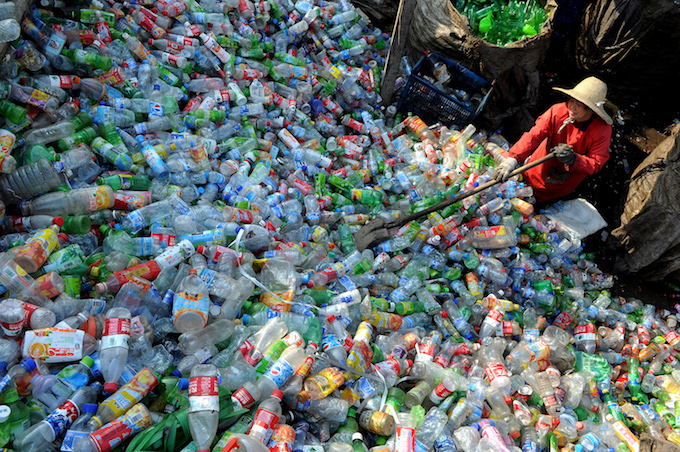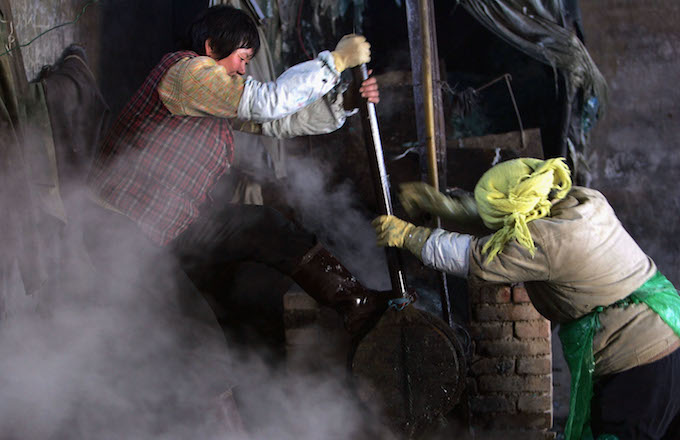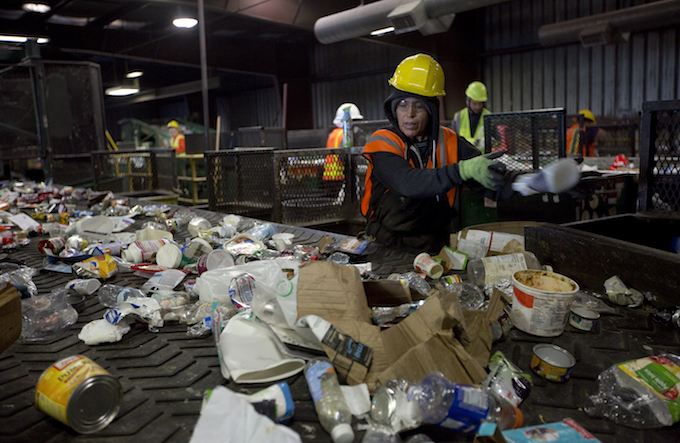As the rest of the world rang in the new year with champagne toasts and lists of changes for 2018, China opted to enact a New Year’s resolution all of its own: to rid itself of the reputation as the “world’s garbage dump.” With the sobering light of post-holiday morning, Western countries around the globe woke up to the startling realization that China no longer wants their recyclables.

A Chinese worker piles up the plastic bottles collected at a recycling centre in east China's Anhui province. | Photo: STR/AFP/Getty Images
China quietly announced this past summer an upcoming policy change effective January 1, 2018 to ban imports of many types of recyclables from the world’s most wasteful countries, such as Canada and the United States. This policy was enacted as a follow up to Operation Green Fence, a year-long program initially developed by the Chinese government in 2013 to crack down on contaminants arriving in China via the import of approximately half the world’s unsorted recyclables. These initiatives clearly indicate to the world that China’s new commitment to environmental protection is incompatible with the West’s casual reliance on passing the buck on recyclables to the Middle Kingdom.
Responsible for importing around 163 million metric tonnes of waste materials every year, China’s policy changes shocked the recycling industry, as it gave them just six months to rethink recycling in the context of their wider waste-management infrastructure. After all the wrapping paper was thrown away and the Christmas boxes flattened and dragged to the curb this January, China effectively closed its doors to the mountains of yang laji - or “foreign garbage” - that has since been piling up in warehouses around the globe.

Workers operate a machine at a plastic waste recycling factory in Heguan Township of Qingzhou City, Shandong Province, China. During production, workers melt waste plastics and ultimately convert them into pellets. They will be sold to factories as raw materials. | Photo: China Photos/Getty Images
The international media claimed that this unprecedented new ban on recyclables was triggered by Plastic China, a documentary exposing the polluting effects of plastics recycling that went viral in January 2017, but promptly disappeared from China’s Internet four days later. Whatever the trigger, the outcome has been a drastic effort by Chinese President Xi Jinping’s administration to ramp up environmental reforms by imposing a ban on four classes and 24 types of solid wastes, including plastic waste, scrap commodities such as metal, and commonly accepted curbside recyclables like mixed paper and cardboard. Adding to China’s expanding green agenda, the policy also sets stringent limits on the levels of impurities accepted in recyclables – a sharp increase in standards that some experts say is virtually impossible to obtain.
So why make this change? Despite a dip in other imports since 2012, China’s recycling market continues to rise. At an annual growth rate of 16.6% between 2012 to 2016, the solid waste recycling industry appears to be capitalizing on other countries’ waste in generating a revenue stream worth nearly US$90 billion every year. It is questionable, then, whether there are motivations behind this ban beyond the narrative China has crafted of a courageous act of environmental stewardship that sacrifices financial gain to save the planet.
The original strategic motivation behind importing the world’s recyclables was to fuel China’s robust manufacturing sector by turning bales of these scraps into usable raw materials. Now that China is moving away from a manufacturing economy toward a consumer economy, it can afford to be pickier in the quality of recyclables it imports. For example, if newspapers placed in recycling bins are tainted with pizza grease, they are too dirty to be directly processed as uncontaminated materials. In fact, if contamination rates are too high for value extraction to be viable, these so-called recyclables are more likely to be sent to the landfill.
With this in mind, China’s new policy also reduces the acceptable contamination rate of imported recyclables from 5 to 0.3 per cent, a drastic shift that countries looking to continue shipping their waste abroad to China will have to adopt – quite literally, by cleaning up their act.
In its attempt to mitigate global environmental woes, however, China’s ban has already begun to create new issues for the environment. Since so many developed countries are overly dependent on China’s recycling industry, the policy change has created a sizeable problem that much of the world is scrambling to fix. These scrap-exporting countries are facing a crisis of rapidly-growing piles of recyclables, with nowhere to dispose of them. If a solution is not found – and quickly – millions of tonnes of orphaned material may continue to be haphazardly thrown into landfills and incinerators.
China’s action in barring cross-border flows of recyclables has brought to the fore the harsh reality that sufficient waste processing capabilities beyond the Great Wall do not really exist. As Canada looks to move ahead with its so-called “clean” brand in industries such as technology, tourism, and agriculture, our country is generally regarded as being environmentally forward-thinking and eco-friendly. However, Canada’s per capita waste output is even higher than that of our consumerist-driven neighbours in the United States.
It is no surprise, then, that China’s changes have not left Canada entirely unscathed. With 21 per cent of recovered plastics in Canada destined for China, municipalities across the country are feeling the pinch. Previously, major Canadian cities such as Halifax and Calgary sent 80 per cent of their recyclables across the ocean. With thousands of tonnes of recyclables stockpiling in warehouses, both cities have been left with no choice but to send accumulating waste to their already overburdened landfills.

Workers sort paper and plastic waste at Far West Recycling in Hillsboro, Oregon. China is sharply restricting imports on recycled materials, and the impact will be felt across the Pacific Northwest. Some of the waste is likely to end up in the region's landfills, as China has rolled out new rules banning imports of 24 types of recyclables and restricting the amount of contamination in other imported waste materials. | Photo: Natalie Behring/Getty Images
But all hope is not lost. The European Union has proposed coping with the regulatory changes by rolling out a tax on plastic bags and packaging. In Edmonton, the first few weeks of the ban have seen extra staff hired and conveyor belts slowed in an attempt to comply with the stiffer standards imposed on contaminated materials sent to China. Meanwhile, many industry players across Canada are calling for an Extended Producer Responsibility (EPR) program, which transfers the responsibility (physical and/or financial) for the proper disposal of products to the producer. An example of this is British Columbia’s EPR initiative, Recycle BC, a non-profit that manages recycling efforts on behalf of the entire province. Recycle BC shares the financial costs of both recycling and ecologically-minded product design amongst businesses that generate recyclable waste. According to Recycle BC’s CEO, this is allowing B.C. to sail along smoothly with little to no impact from stricter regulatory regimes abroad – for now at least.

Workers collect used batteries at Green Eco-Manufacture, China's biggest used home appliance recycling factory, in Jingmen, central China's Hubei province. | Photo: STR/AFP/Getty Images
Although many countries remain pessimistic about the growing piles of global leftovers, it is clear that some, such as Vietnam, Indonesia, and Malaysia, see a golden opportunity to reshape the global recycling economy and capture the value of what China is giving up. Meanwhile, China’s new policy is forcing industries and countries to become more innovative in how they tackle their scrap commodities. While it’s not yet certain exactly how this will play out, one thing is very much assured: without China as a repository for the rest of the world’s recyclable goods, 2018 will be the year many countries must come to terms with the mountains of rubbish they create in their own backyards.





